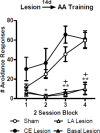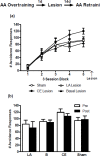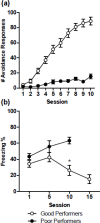Sidman instrumental avoidance initially depends on lateral and basal amygdala and is constrained by central amygdala-mediated Pavlovian processes
- PMID: 20110085
- PMCID: PMC3085029
- DOI: 10.1016/j.biopsych.2009.12.002
Sidman instrumental avoidance initially depends on lateral and basal amygdala and is constrained by central amygdala-mediated Pavlovian processes
Abstract
Background: The lateral (LA) and central (CE), but not basal (B), amygdala nuclei are necessary for reactive Pavlovian fear responses such as freezing. The amygdala also plays a key role in the acquisition and expression of active instrumental defensive behaviors, but little is known about the specific roles of amygdala nuclei. Using a Sidman active avoidance (AA) task, we examined the necessity of LA, B, and CE for learning and performance. Pavlovian freezing was simultaneously assessed to examine the contributions of amygdala nuclei to the transition from reactive to active defensive responding.
Methods: Rats received electrolytic lesions of LA, CE, or B before AA training, or following overtraining. Rats that expressed low levels of AA performance during training received bilateral electrolytic lesions to CE to eliminate competing freezing reactions and rescue AA. AA performance and freezing were assessed.
Results: Damage to LA and B, but not CE, impaired the acquisition of AA. Performance of AA became amygdala-independent following overtraining. CE lesions abolished Pavlovian freezing and rescued instrumental AA performance in rats that expressed low levels of avoidance responses and high levels of freezing during training.
Conclusions: Although the acquisition of Pavlovian fear depends on LA and CE, but not B, acquisition of instrumental AA is dependent on LA and B, but not CE. CE-dependent Pavlovian processes that control freezing can constrain avoidance behavior. Performance of well-trained AA becomes independent of all three amygdala nuclei. Thus, it appears that different output pathways of LA mediate reactive and active conditioned defensive responding.
Figures




Comment in
-
Amygdala activity, fear, and anxiety: modulation by stress.Biol Psychiatry. 2010 Jun 15;67(12):1117-9. doi: 10.1016/j.biopsych.2010.04.027. Biol Psychiatry. 2010. PMID: 20525501 Free PMC article. No abstract available.
References
-
- Bolles RC, Collier AC. The effect of predictive cues on freezing in rats. Animal Learning and Behavior. 1976;4(1):6–8.
-
- Hirsh SM, Bolles RC. On the ability of prey to recognize predators. Zeitschrift fur Tierpsychologie. 1980;54:71–84.
-
- Fanselow MS, Lester LS. A functional behavioristic approach to aversively motivated behavior: imminence as a determinant of the topography of defensive behavior. In: Bolles RC, Bleecher MD, editors. Evolution and learning. Erlbaum; Hillsdale, NJ: 1988. pp. 185–211.
-
- Bolles RC. Species-specific defense reactions and avoidance learning. Psychol. Rev. 1970;77:32–48.
-
- Blanchard RJ, Flannelly KJ, Blanchard DC. Defensive behaviors of laboratory and wild Rattus norvegicus. J Comp Psychol. 1986;100(2):101–7. - PubMed
Publication types
MeSH terms
Grants and funding
LinkOut - more resources
Full Text Sources

